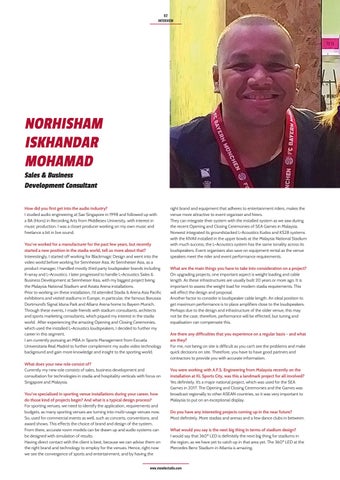62 INTERVIEW
NORHISHAM ISKHANDAR MOHAMAD Sales & Business Development Consultant How did you first get into the audio industry? I studied audio engineering at Sae Singapore in 1998 and followed up with a BA (Hons) in Recording Arts from Middlesex University, with interest in music production. I was a closet producer working on my own music and freelance a bit in live sound. You’ve worked for a manufacturer for the past few years, but recently started a new position in the stadia world, tell us more about that? Interestingly, I started off working for Blackmagic Design and went into the video world before working for Sennheiser Asia. At Sennheiser Asia, as a product manager, I handled mostly third party loudspeaker brands including K-array and L-Acoustics. I later progressed to handle L-Acoustics Sales & Business Development at Sennheiser Asia, with my biggest project being the Malaysia National Stadium and Axiata Arena installations. Prior to working on these installation, I’d attended Stadia & Arena Asia Pacific exhibitions and visited stadiums in Europe, in particular, the famous Borussia Dortmund’s Signal Iduna Park and Allianz Arena home to Bayern Munich. Through these events, I made friends with stadium consultants, architects and sports marketing consultants, which piqued my interest in the stadia world. After experiencing the amazing Opening and Closing Ceremonies, which used the installed L-Acoustics loudspeakers, I decided to further my career in this segment. I am currently pursuing an MBA in Sports Management from Escuela Universitaria Real Madrid to further complement my audio video technology background and gain more knowledge and insight to the sporting world. What does your new role consist of? Currently my new role consists of sales, business development and consultation for technologies in stadia and hospitality verticals with focus on Singapore and Malaysia. You’ve specialised in sporting venue installations during your career, how do those kind of projects begin? And what is a typical design process? For sporting venues, we need to identify the application, requirements and budgets, as many sporting venues are turning into multi-usage venues now. So, used for commercial events as well, such as concerts, conventions, and award shows. This effects the choice of brand and design of the system. From there, accurate room models can be drawn up and audio systems can be designed with simulation of results. Having direct contact with the client is best, because we can advise them on the right brand and technology to employ for the venues. Hence, right now we see the convergence of sports and entertainment, and by having the
right brand and equipment that adheres to entertainment riders, makes the venue more attractive to event organiser and hirers. They can integrate their system with the installed system as we saw during the recent Opening and Closing Ceremonies of SEA Games in Malaysia. Norwest integrated its groundstacked L-Acoustics Kudos and KS28 systems with the KIVAII installed in the upper bowls at the Malaysia National Stadium with much success, the L-Acoustics system has the same tonality across its loudspeakers. Event organisers also save on equipment rental as the venue speakers meet the rider and event performance requirements. What are the main things you have to take into consideration on a project? On upgrading projects, one important aspect is weight loading and cable length. As these infrastructures are usually built 20 years or more ago. It is important to assess the weight load for modern stadia requirements. This will effect the design and proposal. Another factor to consider is loudspeaker cable length. An ideal position to get maximum performance is to place amplifiers close to the loudspeakers. Perhaps due to the design and infrastructure of the older venue, this may not be the case, therefore, performance will be effected, but tuning and equalisation can compensate this. Are there any difficulties that you experience on a regular basis - and what are they? For me, not being on site is difficult as you can’t see the problems and make quick decisions on site. Therefore, you have to have good partners and contractors to provide you with accurate information. You were working with A.F.S. Engineering from Malaysia recently on the installation at KL Sports City, was this a landmark project for all involved? Yes definitely. It’s a major national project, which was used for the SEA Games in 2017. The Opening and Closing Ceremonies and the Games was broadcast regionally to other ASEAN countries, so it was very important to Malaysia to put on an exceptional display. Do you have any interesting projects coming up in the near future? Most definitely. More stadias and arenas and a few dance clubs in between. What would you say is the next big thing in terms of stadium design? I would say that 360º LED is definitely the next big thing for stadiums in the region, as we have yet to catch up in that area yet. The 360º LED at the Mercedes Benz Stadium in Atlanta is amazing.
www.mondostadia.com
